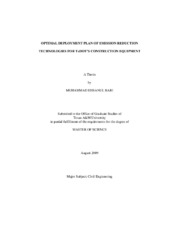| dc.description.abstract | The purpose of this study was to develop and test an optimization model that will
provide a deployment plan of emission reduction technologies to reduce emissions from
non-road equipment. The focus of the study was on the counties of Texas that have
nonattainment (NA) and near-nonattainment (NNA) status.
The objective of this research was to develop methodologies that will help to
deploy emission reduction technologies for non-road equipment of TxDOT to reduce
emissions in a cost effective and optimal manner. Three technologies were considered
for deployment in this research, (1) hydrogen enrichment (HE), (2) selective catalytic
reduction (SCR) and (3) fuel additive (FA). Combinations of technologies were also
considered in the study, i.e. HE with FA, and SCR with FA. Two approaches were
investigated in this research. The first approach was "Method 1" in which all the
technologies, i.e. FA, HE and SCR were deployed in the NA counties at the first stage.
In the second stage the same technologies were deployed in the NNA counties with the
remaining budget, if any. The second approach was called "Method 2" in which all the
technologies, i.e. FA, HE and SCR were deployed in the NA counties along with deploying only FA in the NNA counties at the first stage. Then with the remaining
budget, SCR and HE were deployed in the NNA counties in the second stage. In each of
these methods, 2 options were considered, i.e. maximizing NOx reduction with and
without fuel economy consideration in the objective function. Thus, the four options
investigated each having different mixes of emission reduction technologies include
Case 1A: Method 1 with fuel economy consideration; Case 1B: Method 1 without fuel
economy consideration; Case 2A: Method 2 with fuel economy consideration; and Case
2B: Method 2 without fuel economy consideration and were programmed with Visual
C++ and ILOG CPLEX. These four options were tested for budget amounts ranging
from $500 to $1,183,000 and the results obtained show that for a given budget one
option representing a mix of technologies often performed better than others. This is
conceivable because for a given budget the optimization model selects an affordable
option considering the cost of technologies involved while at the same time maximum
emission reduction, with and without fuel economy consideration, is achieved.
Thus the alternative options described in this study will assist the decision
makers to decide about the deployment preference of technologies. For a given budget,
the decision maker can obtain the results for total NOx reduction, combined diesel
economy and total combined benefit using the four models mentioned above. Based on
their requirements and priorities, they can select the desired model and subsequently
obtain the required deployment plan for deploying the emission reduction technologies
in the NA and NNA counties. | en |


